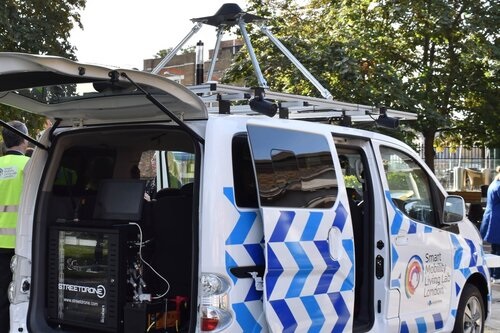Smart cities with autonomous traffic will have to work with all the stakeholders to become a workable reality.
That’s the message from the launch of London’s Smart Mobility Living Lab (SMLL) dedicated to testing automated driving technologies both in the real and virtual worlds. The Lab launched last week boasts a host of on-road and digital testing and appraisal facilities for engineers to resolve issues and see how their driverless technology stands up to an almost infinite variety of scenarios.
It consists of three main sites including an off-road testing ground at east London’s Olympic Park, an on-road monitored network of inner city ‘smart’ roads near its headquarters in southeast London’s Woolwich and a Human Factors Research Lab, based at Loughborough University in the Midlands, that is equipped with a range of equipment to support research into human factors in automation.
The Woolwich site boasts leading-edge ethernet and wifi connectivity, a control room and data center. There are private offices and shared working space for customers, including video and audio conferencing facilities and event space. When asked why London was the chosen site for the innovative research center, Richard Cuerden, director of vehicle safety at the Transport Research Laboratory (TRL) and one of the leading drivers of the project, said it presented near perfect challenges for the technology.
London test-bed
Cuerden explained: “It’s a global center of innovation and Europe’s only megacity and one of the world’s leading smart cities. It is also one of the few places in the world where we can test in such mixed conditions. London also benefits from a world leading mass transport operator in the shape of Transport for London (TfL). So if you bring all these things, placing the Lab in the heart of such a varied and expansive expertise, we can draw upon these sectors to support the development of, and investment in, new mobility services. The perfect way to describe this is if it works in London, it will work anywhere.”
Yet no smart city can hope to fulfill any dream of widespread deployment of AVs without meeting the needs of the urban community, said Trevor Dorling, managing director of smart city technology specialist DG Cities. He suggested: “The question is: what do we wanted to see from future connected mobility cities? The whole purpose of SMLL is to get the view of the people from these local communities that will benefit or suffer from the consequences of new technology. If we do this properly, we will be helping industry because we can help them adapt their thinking, adapt their technology to go with the grain of what a future modern city needs rather than the city trying to fit around what transport or solutions providers are offering.”
Dorling said that this year’s pandemic has already showed society the way forward in maintaining a flexible approach to the development of a cities transport needs and infrastructure. He explained: “We have seen with the consequences of Covid, a rethinking of cities and how they function and how they are designed. We would like to put connected mobility and genuinely smart mobility in the mix in terms of how we look at designing a better city which is resilient and adapts to the needs of people. Some of the main issues, like air quality, congestion and making much better use of our space and including road safety, all of those solutions can be addressed but we need to shape and steer that. That’s the really exciting thing about SMLL because it gives us the forum to discuss and influence those things.”
— Paul Myles is a seasoned automotive journalist based in London. Follow him on Twitter @Paulmyles_
Source: https://www.tu-auto.com
CUT COTS OF THE FLEET WITH OUR AUDIT PROGRAM
The audit is a key tool to know the overall status and provide the analysis, the assessment, the advice, the suggestions and the actions to take in order to cut costs and increase the efficiency and efficacy of the fleet. We propose the following fleet management audit.




